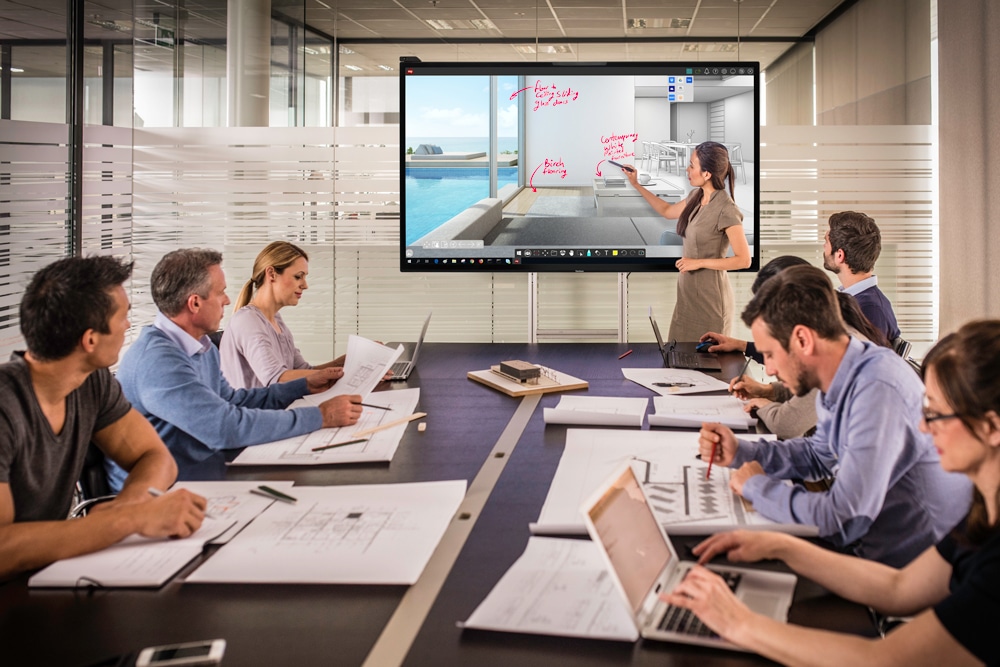You can boost workplace productivity with technology, but it needs the right tools for the job at hand. It’s essential to know your company’s needs given its situation. And technology can enable effective collaboration to vastly decrease the chance of miscommunications. And you’ll see astounding results with better engagement through collaborative tech.
Continue reading to find out how to boost workplace productivity with the right tech.
Discussions of “technology” often focus heavily on the gear, the bells and whistles. Or the emphasis is on abstract concepts like transformation and disruption. The sweet spot is somewhere in between.
In addressing workplace productivity, technology can have a significant impact across the enterprise. But some fundamental questions need to be addressed so technology can play its essential role as an enabling force.
In a global business environment with rapid change as a given, we need a holistic view of the interplay between technology and productivity. Moreover, innovative organizational structures and processes are evolving quickly to address these challenges.
Business Drivers to Consider

First of all, why is productivity important to an organization? The specific reasons vary from business to business, of course, but can include:
- Increasing revenue
- Reducing operational costs
- Accelerating time to market
- Enhancing innovation
- Improving customer experience
- Increasing agility and flexibility
- Heightening staff satisfaction
- Raising overall efficiency
- Strengthening talent recruitment and retention
- Improving employee experience
Taking Stock of the Situation
Let’s address some key questions as the basis for creating a situation analysis for an enterprise:
What does “productivity” mean?
The definition of productivity resides in two perspectives. One is tangible factors such as delivering on specific objectives and tasks, measuring output and efficiencies, achieving effective technology rollouts, and minimizing wasted time. Intangibles include the capability to innovate, engage employees, optimize workflows and break down organizational silos.
“ONLY 60% OF WORK TIME, OR EVEN LESS, IS SPENT BEING PRODUCTIVE.”
How is it being evaluated?
Factors here mirror those definitions in terms of progress in meeting goals, business profitability, ROI on system and process investments, productive vs. idle time, and timely project execution. Interestingly, it appears that there can be some uncertainty as to how productivity is being measured. This situation would indicate a need for better organizational planning, better internal communication or both.
What gets in the way?
Detriments to achieving desired productivity encompass poor planning, organizational inertia, budgets, inefficient workflow, siloed internal functions, and antiquated or inflexible spaces. Technology-related issues include the rapid pace of change, challenges in identifying and evaluating options, effective implementation and training, unreliability, and incompatibility.
“UNNECESSARY MEETINGS COST $37 BILLION IN SALARIES FOR [american] BUSINESSES EVERY YEAR.”
How can it be enhanced?
Again, opportunities for improvement reflect organizational and technological issues in the enterprise. Some best practices are creating an effective digital workplace strategy, developing cross-disciplinary teams, conducting regular situation analyses, setting clear goals to identify technology needs, training users, emphasizing the employee experience, and implementing integrated and intuitive systems.
Who are the key players?
Within the enterprise, the people and roles involved in identifying needs and evaluating potential solutions can be grouped into buckets such as upper management, team managers, team members and support functions like IT, AV and facilities. And, of course, the answers to the first four questions can be different yet complementary, depending on which group is involved.
Significance of Collaboration
One of the most important considerations in addressing enterprise productivity is nurturing a commitment throughout the enterprise to doing everything possible to enhance opportunities and resources for collaboration.

Collaboration is the key to bringing people together from top to bottom in an environment that motivates and facilities interaction, communication, creativity, and innovation. The power of that commitment permeates the ability to address most, if not all, the challenges faced when addressing productivity improvements.
“86% of professionals agree that poor communication results in workplace failures.”
The results can range from seamless project management and organizational agility to more efficient meetings, reduced paperwork, and enhanced employee experience.
As this process evolves, we’re seeing progressive enterprises breaking out of traditional organizational structures to create integrated departments focused on sustainable workspaces or a cross-disciplinary approach to “infrastructure.”
The Digital Workplace
To remain competitive in a global marketplace, enterprises are continuing to shift toward seamlessly interconnecting individuals anytime and anywhere to leverage their collective expertise. To achieve this goal, a well-thought-out digital workplace is designed to break down communication barriers and transform the employee experience by fostering efficiency, innovation, and growth while reducing roadblocks and frustration.

“Teams with high employee engagement rates are 21% more productive.”
Technology resources for boosting productivity span everything from intranets and internal messaging apps to sophisticated videoconferencing and distance communication systems.
In our world of visual solutions, we employ the power of technologies such as advanced interactive displays in a robust software ecosystem to help enterprises boost productivity through collaboration, communication, and interactivity in support of organizational goals and objectives.
And, in order to achieve the optimum results, we believe fervently in taking a team approach that brings together senior management, business team leaders, and end-users as well as IT, AV and facilities support groups to create strategic business solutions that drive business results.
If you have any questions about boosting productivity through collaboration, communication, and interactivity, or if you would like to know more about the digital workplace, please do not hesitate to contact us at salesinfo@viewsonic.com.
By Chris Graefe, Director, Enterprise Sales, ViewSonic